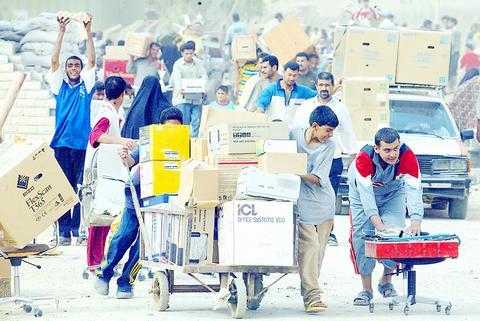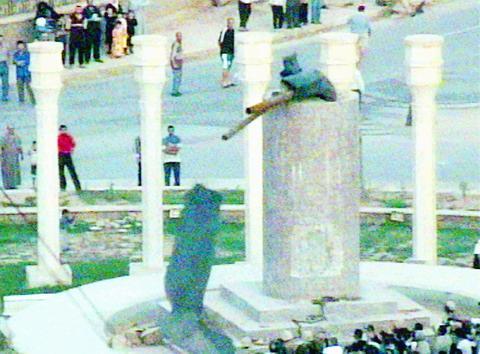US tanks and troops poured into the heart of Baghdad amid scenes of jubilation yesterday as Iraqi President Saddam Hussein's regime collapsed under a blistering three-week onslaught.
US forces met little Iraqi resistance as they took over swathes of the city, with looting erupting as it became clear that Saddam's 24-year stranglehold on the Iraqi people was disintegrating.
Tanks rolled into the heart of the city, with US soldiers helping jubilant Iraqis tear down a giant statue of Saddam in the Al-Fardus (Paradise) Square.

PHOTO: AP
They slung a thick rope noose around the Iraqi leader's neck, and controversially briefly draped the Stars and Stripes over his head.
Civilians queued up to hammer blow after blow into the plinth supporting the statue, while nearby soldiers chatted to journalists, the hatches of their tanks open, although other Marines on foot took up precautionary positions.
"The reception by the Iraqis was very warm and this was a big surprise to us. People are very nice," Staff Sergeant Daniel Attilio said.

PHOTO: REUTERS TV
US troops spread through the city to crush remaining pockets of resistance, facing snipers and isolated units prepared to make a last stand.
"Good, Good, Bush!" chanted cheering crowds in a northern district of Baghdad as a US Marine convoy passed by, as elsewhere angry crowds defaced and destroyed symbols of Saddam's regime.
US President George W. Bush was said by an administration official to be pleased with progress in the campaign, while Vice President Dick Cheney warned that "hard fighting" could lie ahead.
British Prime Minister Tony Blair, Washington's staunchest ally in the three-week-old war to wrench power from Saddam, warned: "This conflict is not, however, over yet."
Mystery still surrounds the fate of Saddam, who it is thought may try to make a last stand at his home-town of Tikrit north of Baghdad.
White House spokesman Ari Fleischer said Saddam had "missed his chance" to go peacefully into exile, hinting the administration believed the Iraqi leader still to be alive. "We still don't know his fate."
A spokesman for Blair said Iraq's command and control structure appeared to have broken down in Baghdad, adding that scenes of chaos and looting in the capital "tell their own story."
But he warned resistance to advancing US troops could still be quite "stubborn and fierce" after days of bloody fighting to wrest control of the capital of 5 million people, now largely deserted by pro-regime forces.
In the streets of Baghdad, people dared to utter the words "Traitor!" "Torturer!" "Dictator!" in reference to Saddam.
"We're ecstatic to get rid of him after all these years of war and deprivation," said Dinkha Khosina, joining hundreds of Iraqis to greet US troops racing from Baghdad's northern entrance to the heart of the capital.
"Welcome, welcome!" Baghdadis cried out in English, as young people took off their T-shirts and waved them in joy in front of the US soldiers.
"This is the greatest feeling I've had in my life, after spending 11 years in military service because of all the wars Saddam has put us through," said Ayub, who did not want his family name used.
In Saddam City, Baghdad's teeming Shiite suburb, people were seen breaking into shops and homes to steal furniture, food, electrical equipment and carpets.
In the north of the capital, citizens rampaged through the interior and irrigation ministries, gutting the offices, reporters said, while symbols of Saddam's iron grip on the country took the brunt of people's anger.
In other parts of the capital, Baghdadis tore up a giant portrait of Saddam, men brandished Kalashnikov rifles as they signalled their delight at the regime crumbling, while one white-haired man was seen laughing as he repeatedly hit at a poster of Saddam with a sandal.
City residents, hardened after almost 13 years of crippling economic sanctions, started looting symbols of Saddam's power, notably the irrigation and interior ministries and the headquarters of the Iraqi Olympic Committee, run by Saddam's elder son Uday.
US troops, moving up the eastern bank of the Tigris, approached the center of the capital, where they were expected to join units controlling the western side of the river, witnesses said.
Marines had seized Baghdad's eastern zone, though Iraqi snipers were still posing problems, a US military official said.
Allied warplanes still flew over the capital as smoke filled the skies, bringing air support to ground troops moving through the east and north of Baghdad where Iraqi forces had abandoned positions.
Dozens of Iraqi and Arab fighters in civilian clothing were still holed up behind buildings or in sandbagged positions on the western side of the Al-Jumhurya bridge spanning the river Tigris.
"Baghdad has not fallen and will never fall," said Mohammed al-Dahruj, a 24-year-old Syrian who volunteered to fight US-led forces.
At Sulaymaniya in the north of the country, streets erupted into a carnival atmosphere as tens of thousands of Kurds danced and sang at the news that US tanks controlled the center of Baghdad.
In southern Iraq, Basra was not yet totally under British control, Blair said.
"It is not secure for our troops yet, fully," he said. "[But it is] more under control today than it was yesterday."
Nothing has been heard from Saddam since a US bomber on Monday obliterated the building in Baghdad where he was believed to be with his two sons.
Major General Stanley McChrystal, with the US Joint Chiefs of Staff, said the air strike had been "very, very effective," but it was not known if the targets were still alive.
The Times of London said British intelligence believed Saddam had left the targeted building just before it was bombed.
The Washington Times quoted a US official as saying that US intelligence was "in a state of euphoria" because "there is no doubt he [Saddam] is dead."

The CIA has a message for Chinese government officials worried about their place in Chinese President Xi Jinping’s (習近平) government: Come work with us. The agency released two Mandarin-language videos on social media on Thursday inviting disgruntled officials to contact the CIA. The recruitment videos posted on YouTube and X racked up more than 5 million views combined in their first day. The outreach comes as CIA Director John Ratcliffe has vowed to boost the agency’s use of intelligence from human sources and its focus on China, which has recently targeted US officials with its own espionage operations. The videos are “aimed at

STEADFAST FRIEND: The bills encourage increased Taiwan-US engagement and address China’s distortion of UN Resolution 2758 to isolate Taiwan internationally The Presidential Office yesterday thanked the US House of Representatives for unanimously passing two Taiwan-related bills highlighting its solid support for Taiwan’s democracy and global participation, and for deepening bilateral relations. One of the bills, the Taiwan Assurance Implementation Act, requires the US Department of State to periodically review its guidelines for engagement with Taiwan, and report to the US Congress on the guidelines and plans to lift self-imposed limitations on US-Taiwan engagement. The other bill is the Taiwan International Solidarity Act, which clarifies that UN Resolution 2758 does not address the issue of the representation of Taiwan or its people in

US Indo-Pacific Commander Admiral Samuel Paparo on Friday expressed concern over the rate at which China is diversifying its military exercises, the Financial Times (FT) reported on Saturday. “The rates of change on the depth and breadth of their exercises is the one non-linear effect that I’ve seen in the last year that wakes me up at night or keeps me up at night,” Paparo was quoted by FT as saying while attending the annual Sedona Forum at the McCain Institute in Arizona. Paparo also expressed concern over the speed with which China was expanding its military. While the US

SHIFT: Taiwan’s better-than-expected first-quarter GDP and signs of weakness in the US have driven global capital back to emerging markets, the central bank head said The central bank yesterday blamed market speculation for the steep rise in the local currency, and urged exporters and financial institutions to stay calm and stop panic sell-offs to avoid hurting their own profitability. The nation’s top monetary policymaker said that it would step in, if necessary, to maintain order and stability in the foreign exchange market. The remarks came as the NT dollar yesterday closed up NT$0.919 to NT$30.145 against the US dollar in Taipei trading, after rising as high as NT$29.59 in intraday trading. The local currency has surged 5.85 percent against the greenback over the past two sessions, central